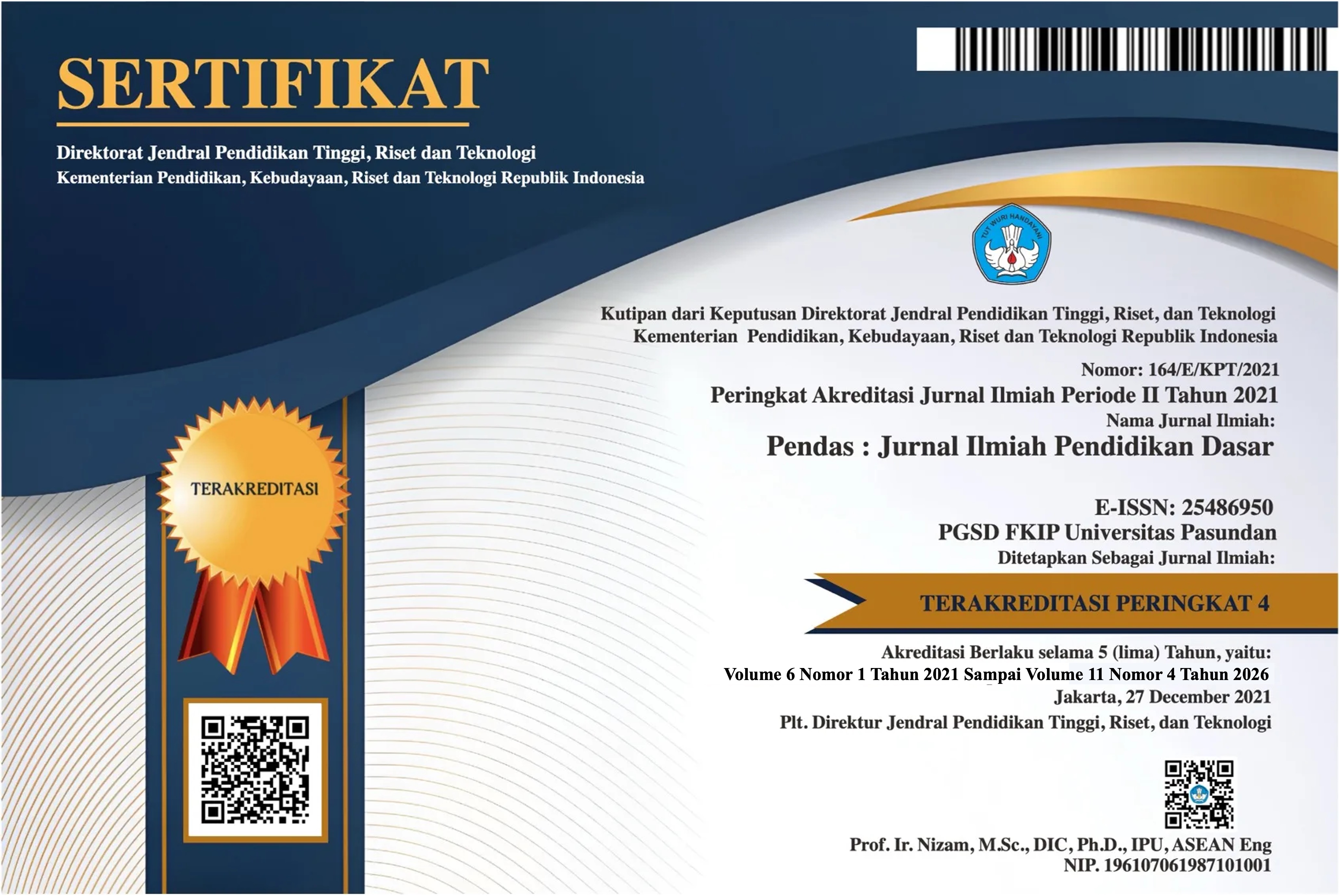MENINGKATKAN AKTIVITAS, KREATIVITAS, DAN HASIL BELAJAR PESERTA DIDIK MENGGUNAKAN MODEL BRILIAN DI SEKOLAH DASAR
DOI:
https://doi.org/10.23969/jp.v9i2.15917Keywords:
Activity, Creativity, Learning Outcomes, BRILIAN ModelAbstract
The problem in this study is the low activity and creativity of students in the content of Natural Sciences (IPA) which causes not maximizing learning outcomes. The effort to overcome these problems is by applying the BRILIAN model. This study aims to describe the activities of educators, analyze the improvement of students' activities, creativity, and learning outcomes. This research is a Classroom Action Research (PTK) conducted with 4 meetings. The subjects of this study were fifth grade students of SDN Karang Mekar 4 Banjarmasin, with 26 students consisting of 11 boys and 15 girls. The research was conducted in the second semester of the 2023/2024 school year. This research uses a qualitative approach. The data taken is qualitative data obtained through observation of educator activities, learner activities and learner creativity, then using quantitative data for student learning outcomes obtained through written tests in groups and individually. Data analysis in this study used descriptive analysis techniques and was described in tables, graphs and interpretations with percentages. The results of this study indicate that the activities of educators increased from a score of 18 to 27 with "Very Good" criteria. Learner activity increased from a percentage of 27% to 96% with the criteria "Very Active". Learners' creativity increased from a percentage of 27% to 96% with the criteria "Very Creative". Classical learner learning outcomes from a percentage of 54% to 100% reached classical completeness. Based on the results of the study, it can be concluded that the use of the BRILIAN model can increase the activity, creativity, and learning outcomes of students. Keywords: Activity, Creativity, Learning Outcomes, BRILIAN ModelDownloads
References
Afif, K., Sunismi, & Alifiani. (2021). Pengembangan Bahan Ajar Interaktif Bermuatan 6C (Critical Thinking, Creative Thinking, Collaboration, Communication, Character, dan Citizenship) pada Materi Pola Bilangan Kelas VII. Jurnal Penelitian, Pendidikan Dan Pembelajaran (JP3), 16(1), 184–293.
Agusta, A. R., dkk. (2022). Model Gawi Sabumi Berbasis Lingkungan Lahan Basah Untuk Mengembangkan Kesadaran Ekologi Dan Keterampilan Berpikir Tingkat Tinggi. Prosiding Seminar Nasional Lingkungan Lahan Basah Volume 7 Nomor 1Halaman 45-56 April 2022
Asran, Nadiroh, & Solihatin, E. (2019). Pengaruh model pembelajaran dan gaya belajar kerhadap Kemampuan berpikir kritis (studi eksperimen siswa kelas V pada mata pelajaran ilmu pengetahuan sosial di sekolah dasarnegeri Bulurokeng Kota Makassar). Jurnal Tunas Bangsa, 6(2), 251–265.
BSNP. (2006). Standar Isi Untuk Satuan Pendidikan Dasar dan Menengah Standar Kompetensi dan Kompetensi Dasar SD/MI. Journal of Education, 53(9), 1689–1699.
Hidayat, A., Jannah, F., & Udzmah, N. (2021). Implementasi Model Bahimat Meningkatkan Aktivitas Dan Hasil Belajar Siswa Sekolah Dasar Pada Muatan Pkn. Jurnal Pendidikan Kewarganegaraan, 11(2), 31–38.
Jannah, F. (2018). Efektivitas Penelitian Tindakan Kelas (PTK) Bagi Guru di SDN 2 Sumanggi Kecamatan Batang Alai Kabupaten Hulu Sungai Tengah.
Jannah, F., Sari, R., Prihandoko, Y., Dwi Prasetyo, Y., & Indriati, S. (2023). Improving Science Learning Activities and Outcomes Using an “Internal” Learning Model. JURNAL PAJAR (Pendidikan Dan Pengajaran), 7(1), 192. https://doi.org/10.33578/pjr.v7i1.9002
Jannah, P. N. (2020). Implementasi Model Pembelajaran Kooperatif Tipe Student Facilitator and Explaining Dengan Menggunakan Media Promak (Putaran Roda Norma Kehidupan) Untuk Meningkatkan Minat dan Hasil Belajar Peserta Didik Pada Mata Pelajaran Ilmu Pengetahuan Alam Di Min 1 P.
Jannah, Fathul, dkk. (2022). Pembelajaran Hots Berbasis Pendekatan Lingkungan Di Sekolah Dasar. Jurnal Pendidikan Guru Sekolah Dasar Volume 11 Nomor 1 Februari 2022
Jannah, F., Karnalim, O., Permadi, A., Murad, D. F., Aditya, B. R., Andrisyah, A., & Nurhas, I. (2022). Pendidikan Desain Kuis HOTS Interaktif Dengan Aplikasi Kahoot! Dan Quizziz di Masa Pandemi: Studi Kasus Guru Sekolah Dasar Gugus Pangeran Antasari Kota Banjarbaru. JCES (Journal of Character Education Society), 5(1), 243-251.
Jannah, Fathul. dkk. (2022). Meningkatkan Hasil Belajar Siklus Air Menggunakan Model Investigation, Intellectually, Tournament. Jurnal Pendidikan Guru Sekolah Dasar Volume 11 Nomor 1 Februari 2022.
Maryance, R. T., Ita, E., Nurmalina, Haris, I., & Wahab, A. (2021). Teori dan Aplikasi Manajemen Pendidikan. In Yayasan Penerbit Muhammad Zaini.
Noorhapizah, O., Pratiwi, D. A., & Ramadhanty, K. (2022). Meningkatkan Keterampilan Berpikir Kritis Menggunakan Smart Model Untuk Siswa Sekolah Dasar. JCI Jurnal Cakrawala Ilmiah, 2(2), 613–624.
Prihandoko, Yogi. dkk. (2020). Pendidikan Pembelajaran dan Penilaian Berbasis HOTS Bagi Guru SD SeKecamatan Mantrijeron Kota Yogyakarta. Jurnal Ilmiah Pengabdian kepada Masyarakat, Vol 5 No 4, September 2020, Page 394-403 p-ISSN:250
Radiansyah, R., Sari, R., Jannah, F., & Masdiyar, M. (2022). Meningkatkan Hasil Belajar Siklus Air Menggunakan Model Investigation, Intellectually, Tournament. Primary: Jurnal Pendidikan Guru Sekolah Dasar, 11(1), 150–160. https://doi.org/10.33578/jpfkip.v11i1.8518
Sari, K. P., S, N., & Irdamurni, I. (2020). Pengembangan Kreativitas Dan Konsep Diri Anak Sd. Jurnal Ilmiah Pendidikan Dasar, 7(1), 44. https://doi.org/10.30659/pendas.7.1.44-50
Sari, R., Jannah, F., & Rahmi, N. (2023). Meningkatkan Aktivitas, Motivasi Dan Hasil Belajar Menggunakan Model Ground Peat Untuk Siswa Sekolah Dasar. DIKSEDA: Jurnal Pendidikan Sekolah Dasar, 1(01), 47–62. https://dikseda.winayailmu.id/index.php/1/article/view/5
Sitepu, E. N. (2021). Media Pembelajaran Berbasis Digital. Mahesa, 1(1), 242–248. https://doi.org/10.34007/ppd.v1i1.195
Suriansyah, A., Amelia, R., & Lestari, M. A. (2019). Meningkatkan Aktivitas Belajar Siswa pada Mata Pelajaran Matematika Menggunakan Kombinasi Model Problem Based Learning (PBL), Think Pair And Share (TPS) dan Teams Games Tournament (TGT) di Kelas VB SDN Teluk Tiram 1 Banjarmasin. Prosiding Seminar Nasional PS2DMP ULM, 5(1), 27–36. https://www.rumahjurnal.net/index.php/PS2DMP/article/view/797
Taufik, N., & Narawaty, D. (2022). Kurikulum 2013 , Kurikulum Darurat ( 2020-2021 ), Dan Kurikulum Prototipe Atau Kurikulum Merdeka ( 2022 ) Mata Pelajaran Bahasa Inggris : Suatu Kajian Bandingan. Sinastra, 1(1), 373–382.
Ulfah, & Arifudin, O. (2021). Pengaruh Aspek Kognitif, Afektif, Dan Psikomotor Terhadap Hasil Belajar Peserta Didik. Jurnal Al-Amar (JAA), 2(1), 6. http://ojs-steialamar.org/index.php/JAA/article/view/88
Downloads
Published
Issue
Section
License
Copyright (c) 2024 Pendas : Jurnal Ilmiah Pendidikan Dasar

This work is licensed under a Creative Commons Attribution 4.0 International License.



















